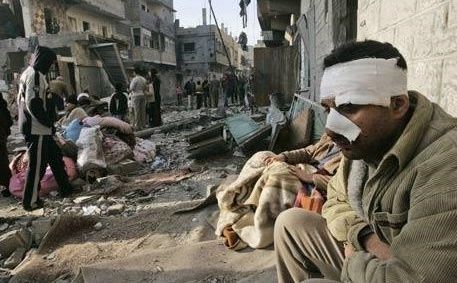Sometimes, editors need an image for a story but don’t have anything useful or available right away.
That’s when stock photos come in handy.
But unless they’re clearly labeled as “file photos” used for “illustrative purposes,” these images can be very misleading.
Robert Fisk raises an important point about “generic” news photos used to illustrate articles.
Some 20 years ago, I made a series of documentaries on the Middle East under the title From Beirut to Bosnia. During the course of our filming, we shot footage of Palestinian youths throwing stones at Israeli soldiers in the Gaza Strip in protest at the destruction of dozens of homes by Israeli forces. Some hours later, I was watching a news report on CNN on the return of the Palestinian delegation from fruitless peace talks with the Israelis. In this same report, the very same Palestinians – I recognized them individually – were seen throwing the same stones. But the report said they were ‘protesting’ at the peace talks. They were not, of course. But when I asked the CNN Bureau Chief in Jerusalem to explain the pictures, he said that Palestinians disapproved of the way the talks were going and that the pictures of the protestors were ‘generic’.
The implication, of course, was that the Palestinians usually protested, and protested with stones; indeed, that Palestinians were generically violent people. Yes, Palestinians did throw stones at Israeli soldiers. And these Palestinians were throwing stones at Israeli soldiers. But they weren’t throwing stones at them for the reasons stated in the report. ‘Generic’ footage was being used to illustrate a story that did not even touch on the reasons for the violence we were actually watching on the screen.
Three quick thoughts:

1. Recycled images can indeed distort reality. One especially blatant example was when the Daily Telegraph recycled a photo of destruction from Operation Cast Lead to illustrate an article on Gaza poverty a year later.
2. The dynamics driving Mideast photos make it hard to believe papers won’t usually have current images on hand. As photojournalist Ruben Salvadori revealed, editors are hot for photos of street clashes, photographers know those are the shots that they’ll get more money for, and the rock-throwers are more than happy to cooperate with the cameramen.
3. The perception reinforced by years of biased photography (detailed in HonestReporting’s Shattered Lens report on wire service images) depicting Palestinian rock throwers as heroic has finally brought us to the point where editors think Palestinians aren’t just violent, but — in Fisk’s words –“generically violent.” What Fisk means by generically violent is a media portrayal of Palestinians stemming from preconceived notions, not from objective fact or from anything we can call honest reporting.
Now, if photo bias is having a cumulative effect on the way Big Media and the world regards the Palestinians, what does that say about the long-term effects of irresponsible imagery on Israel?
(Image of stone thrower via YouTube/Raul Alejandro)

